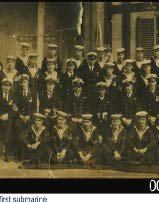Lieutenant Commander Thomas Besant, Royal Navy
Lieutenant Commander Thomas Fleming Besant, RN, Commanding Officer HMAS AE1

Hailed as “one of the most skilful, alert and fearless” of Britain's Royal Navy submariners, Lieutenant-Commander Thomas Flemming Besant was destined to play a central role in Australia's submarine history.
Of the “silent service”, Besant said, "It is not all beer and skittles. And perhaps it is a harder life than in other branches of the service but it's the life I've chosen. Oh, yes, it's dangerous, if you want to look at it like that, but it's got to be done and every man in the Navy, no matter in what branch of it he is, has to be prepared to meet danger when it comes."
Born in Liverpool, Besant was specially chosen to bring out the RAN's first submarine, the E Class AE1, to Australia, reaching Sydney on 24 May 1914. At the time it was the longest voyage ever undertaken by a submarine; 83 days.
Besant appeared undaunted by the odyssey. Waiting media remarked on his quiet authority, and clean shaven, youthful appearance. The Herald newspaper noted; “it was hard to realise that he had been spending a large part of the last nine or ten years underwater. But it was so. It is nearly ten years since he first joined the submarine service. For some time, he was second in command of various submarines in the Royal Navy, and then took the command of what was known as a Holland submarine-No. 5 and afterwards had command of the A6, C12, and C30.”
Besant commanded HMAS AE1 when it was deployed as part of the Australian Naval and Military Expeditionary Force sent to attack German New Guinea. Along with AE2, she took part in operations leading to the occupation of the German territory, including the surrender of Rabaul on 13 September 1914. AE1 was on a war patrol protecting the fleet anchorage when she disappeared the following day 14 September 1914.
It was Australia's first major loss of World War 1.
A subsequent forensic investigation in 2018 concluded that an attempt to make conditions aboard AE1 more tolerable in the tropical heat was possibly to blame. A ventilation valve was unsecure when the submarine dived, causing the engine room to flood and total loss of control of the AE1. The vessel subsequently sank below 100 metres and imploded, killing all 34 aboard instantly.